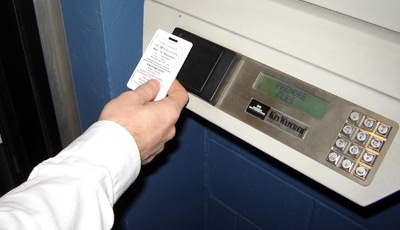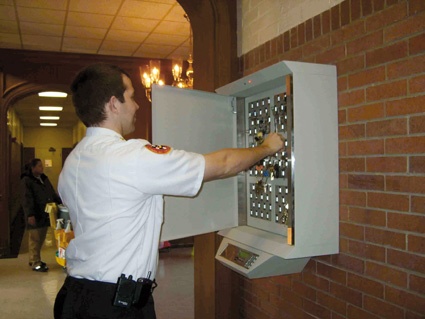How to Pick a Key Control and Asset Management System
Since their debut in the marketplace more than 20 years ago, automated key control systems have maintained popularity for their capacity to manage and monitor keys seamlessly. Now ...


Since their debut in the marketplace more than 20 years ago, automated key control systems have maintained popularity for their capacity to manage and monitor keys seamlessly. Now enhanced technology and network capability are strengthening the arguments to introduce a key control solution even further.
In locations such as casinos and gaming, correctional facilities, health care institutions, hospitality businesses, multi-family buildings and educational facilities, key control management systems are a proven solution to enhance physical security. Key control is also a critical function for anyone overseeing security at conference centers, government agencies, control rooms, automotive businesses and corporate buildings.
Automated key control systems provide a higher level of access control through sophisticated technology that offers secure storage of keys and enables the programming of user restrictions or parameters for optimum key control and management. Users can only remove the key they are authorized to use by entering a pre-programmed PIN code, scanning their access card or giving biometric identification. If the criteria entered matches the information stored in the system database, the key cabinet will unlock and the necessary key can be removed or returned. The other keys will remain locked into place.
Improved Operating Technology
Online monitoring, updating and reporting capabilities enhance the functionality of a key control system and add to the integrity of the overall security plan. At any time, security operations can determine in which cabinet a key is stored, which keys are available for access, view who currently has which keys out and for what area and when they are scheduled to be returned or who has taken keys out, for what areas and at what times. When keys are not returned when scheduled, e-mail alerts can be sent to management to allow quick action.
Key control solutions are further enhanced with supporting operational software. The software can run activity reports, sort events based on different criteria and also view and print reports. Depending on the type of system, the software will either poll the individual key control cabinets for the data or, in the more advanced key management systems, the system will automatically send the transaction information back to a central server, allowing system managers to sort and analyze information to maintain maximum control of access and security issues. The management software also maximizes the programmable access capabilities of the system. For example, in the late evening when an employee has called in sick and another staff member must cover for that individual, it's much easier for the manager to remotely authorize access to a key cabinet than to physically travel to the site to release a key.
Integration Increases Value
Key management systems can also reinforce physical security systems and policies that are already in place. Today's updated approach to key management security is designed for complete interactivity with other business and security systems. Critical information about key control can be communicated across multiple systems, enabling additional or immediate security action to be taken. Open protocols enable connectivity to access control and other systems provided by a range of integration partners, allowing systems to be connected to edge devices via RS-232 or networked via Ethernet. The transparency of the integration allows for the functioning of each of the discrete processes while simultaneously and seamlessly merging the related functions.
Using a common front-end database, the area of movement for staff with keys can be defined by the parameters within the building that are managed by various access-controlled doors. An example of this would be a user who has taken a specific key and then is denied egress from the facility until the key is returned. Selected management can be alerted via email if a high security key has been accessed or not returned on time. In network-enabled key control systems, authorization codes can be changed instantly to help prevent incidents such as allowing access to a recently terminated employee. The parameters can be applied to users, to keys, groups of keys, time restraints or reservations.
Network access and the compatibility with other systems offer an added richness and usability to the key control and management system. Optimizing the key management and access control technology within a facility through system integration pays obvious rewards in terms of ROI (return on investment) by allowing optimum security solutions to be maintained without the need to overhaul or replace costly installations.
What‘s in the Box?
The functionality of key control systems continues to expand, with new features such as custom modules to accommodate valuable items. Lockers, available in various sizes, can be used for storing small firearms, cell phones, 2-way radios and other valuables. Items can be returned to any open locker for convenience, and systems can be set up as a personal storage space for one or multiple users. These asset management systems can also be configured with additional security features to help maintain the integrity of the system. For example, where protection of asset lockers itself is mission-critical, installation of a remote access device provides an additional layer of protection by enabling the locker system to be placed in a secure room. A second individual's PIN input and verification is then required in order for an authorized employee to access the contents of a locker.
Multiple cabinets and/or lockers can form a single fully integrated system to hold hundreds of keys and other items in multiple locations, all controlled from a single PC interface. Systems can be custom designed to meet users' specific needs including mechanical key storage modules, key card-style modules and lockers of various sizes or simply blank modules to be filled at a later time. The scalable systems can also be tailored to suit a variety of access control needs with features including a built-in keypad, biometrics such as fingerprint readers, and a magnetic or proximity card reader.
To guard against tampering or vandalism, key control systems can offer a number of built-in safety features. Tamper-proof mechanisms trigger an alarm under a range of conditions including the use of force to gain access or remove a key, three consecutive invalid user codes or a door left open for more than 10 seconds after use. Systems can also trigger the alarm if there is a power failure, a key is missing or not returned on time or a key is returned by the wrong user. Each key storage system is powered by AC electricity and supported by a 48-hour backup power supply. With their ease of use and long list of security benefits, key control systems will undoubtedly continue their run as an important component of the security management arsenal.
Business Partner
Morse Watchmans2 Morse Road
CT 06478 Oxford
UK
most read


Security management, building security & perimeter protection: the winners of category E at the GIT SECURITY AWARD 2026
GIT SECURITY AWARD 2026: Security management, building security & perimeter protection - an overview of the most innovative solutions


Machine & plant safety: The winners of category A at the GIT SECURITY AWARD 2026
GIT SECURITY AWARD 2026: Machine & plant safety - an overview of the most innovative solutions

Integrated and Futureproof: Traka’s Next Chapter
Interview with Stefni Oliver on Traka’s Vision for the Future








